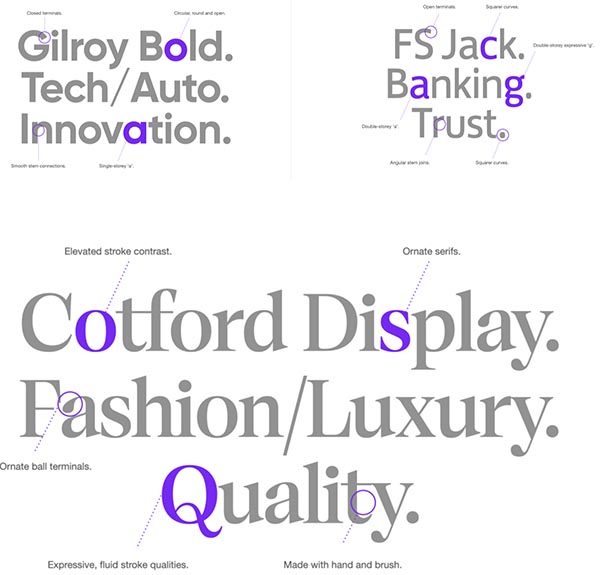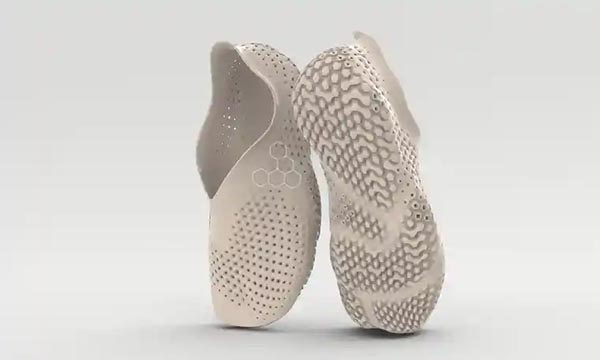
Fonts of Knowledge…and Vice Versa
We all know that typography conveys a meaning beyond its content. The typeface chosen for any particular purpose is the key element of visual identity, especially when it comes to branding. Think how seriously we would take something like Scientific American if all the articles were typeset in Comic Sans. But Printmagazine asks, “do we always consider cultural differences when finding the right font and aligning it to the strategy and design system?” To understand how culture, gender, and geography impact the perception of type, Monotype and Neurons, an applied neuroscience company, teamed up to conduct a study to answer “questions about the cultural differences in perceiving meaning and emotion in type.”
Monotype has released the first results of their ongoing study, revealing the emotional impact and cultural nuances of fonts across eight different countries: Australia, France, Germany, Japan, Portugal, Spain, the UK, and the US (with plans for more).
Some findings:
France, Portugal, and Spain preferred classic serif styles. All three countries scored highly for associations such as surprising, so they might be the perfect market to try something more avant-garde or shocking.
Unlike many of its Romance language-speaking neighbors, the research found that Germans favored bold visuals and tended to value prominence and memorability. Germany scored lower on all other emotional attributes, such as trust, honesty, and quality.

In Japan, handwritten type and traditional forms are preferred.
The Japanese audience scored gothic, low-contrast, humanistic fonts highly for innovation. With its expressive brushwork and embellished serifs, Shuei Min scored highly for trust, honesty, and authenticity.
…“Everyone brings their own history and personal perceptions to a typeface,” says Phil Garnham, Executive Creative Director at Monotype. “But what’s fascinating about our research is that it reveals those perceptions are, at least in part, influenced by where we live and the history of our culture and language.”
Interesting stuff. Initial findings, samples, and survey methodology are presented in an e-book, available at Monotype – Typography Matters.
Signs of the Times: Through the Looking-Glass
Ever heard of an “infinity mirror”? We confess, we had not. It is:
a configuration of two or more parallel or angled mirrors, which are arranged to create a series of smaller and smaller reflections that appear to recede to infinity
Ah. Core 77 adds, “Infinity mirrors are the tacky domain of party buses and post-college first apartments.” But they also point out that in China, infinity mirrors are being used to create cool effects in neon or LED signage:

We haven’t seen this in the US yet—we’re surprised someone in Vegas hasn’t seized on it. (If someone has, let us know!)
More Signs of the Times: Social Butterflies
We think of signage as just being for humans, but one road sign in Canada wishes monarch butterflies a safe migration.
From the Instagram post:
Every year monarch butterflies travel up to 3000 miles from the United States and Canada to central Mexico to escape the winter cold. Also check out some very cool monarch migration pictures.

Adds Boing Boing:
Some populations of the Monarch butterfly are classified as endangered. If you live in the relevant climate zones, you can help save them!
The Full Monty
You can probably figure out the first thing that popped into our heads when we saw this headline at Atlas Obscura: “Flying Circuses Led to the First Aerial Maps of Earth.” But the story itself is pretty interesting. We associate flight with the Wright Brothers and airplanes, but the first manned flight was some 120 years before Kitty Hawk: on November 21, 1783, near Paris, the Montgolfier brothers launched two passengers in a hot-air balloon who sailed 5.5 miles through the air in 25 minutes.
Almost immediately, the first manned flight set off a “balloon craze” throughout Europe. Balloonists traveled from city to city, attracting large crowds with their “flying circuses” (hence, the term well-known to Monty Python fans). The novel apparitions caused some to faint, others to vomit. Destruction and rioting were not uncommon.
Funny how air travel hasn’t changed all that much.... But two years later, balloon mania also led to another first: the first aerial maps.
On September 8, 1785, Thomas Baldwin saw something nobody had ever seen before: the English city of Chester and its surroundings from above. And then he did something nobody had ever done before: He produced maps of what he saw—the very first aerial maps in history. They’re included in Airopaidia, a curious book that devotes hundreds of pages to Baldwin’s one and only balloon trip.

Thomas Baldwin/Smithsonian Libraries
There’s always a spoil-sport:
Lamenting the “balloonomania” of his day, novelist Horace Walpole complained that “all our views are directed to the air; balloons occupy senators, philosophers, ladies, everybody.” He hoped that these “new mechanic meteors” would not be “converted into new engines of destruction to the human race, as is so often the case of refinements or discoveries in science.”
Hah! Just wait…
And of course Monty Python did do a series of sketches on “The Golden Age of Ballooning.”
Pane Points
Here’s a cool idea, developed by South Korea’s ITRI (Industrial Technology Research Institute): the AR Interactive Vehicle Display, which is initially being targeted at tour bus operators. Via Core 77:
“The AR Interactive Vehicle Display is a transparent display that allows passengers to view and interact with augmented reality (AR) content without the need to wear any devices in a moving vehicle. When passengers spot a site of interest, visual information is presented in real time, following their line of sight. Passengers can touch a visual cue on the screen to access detailed information. The system can be customized for various modes of transportation and incorporated into vehicle windows, in-car displays, and personal mobile devices.”

Now, those who are prone to motion sickness may have some concerns, but they’ve thought of that:
An on-screen visual aid that moves according to the vehicle’s motion is provided to mitigate motion sickness. The solution prevents passengers from feeling dizzy or nauseous while viewing AR content via a transparent display on a moving vehicle.
This could also be the future of GPS if the technology could be embedded into car windshields.
The Eyes Have It
One of the disadvantages of being…past a certain age is the complicated arsenal of eyewear that is required to get through the day, from dedicated reading glasses (in every room!), to progressive lenses so you don’t have to keep taking readers on and off, and can maneuver around a grocery store while also being able to determine how many cups or ounces a particular item contains. And some people need different types of reading glasses—if they’re doing finely detailed intricate work vs. reading a book vs. working on the computer. And Zoom calls!
At any rate, via Core 77, a Japanese company called Vixion may have a solution. “Their Vixion 01 eyewear, designed by Nendo, is a pair of auto-focusing eyeglasses.”
Built-in sensors track your eyes and measure the distance to what you're looking at, and instantly, automatically change the lens shape to provide the proper focus. This video released by the company simulates the experience of going from reading-distance to looking-out-the-window:
The glasses weigh 50g (1.8 oz), and the USB-C-rechargeable battery is good for up to 10 hours, the company reports. To turn them on, you simply open the stems, specifically the right one. Folding the glasses shut turns them off.
Take our money!

Well, OK, maybe not.
Graphene Wears Well
Was it a good week for graphene news? It’s always a good week for graphene news! The graphene-based “Everything Proof Pants & Shirt.” From The Graphene Council:
Graphene-X, the Hong Kong-based pioneer in graphene-integrated adventure clothing, is set to launch its latest products on Kickstarter. The “Everything Proof Pants & Shirt” kit, featuring state-of-the-art materials technology, is designed to withstand the harshest conditions, making it the ideal gear for any adventure.
… The Everything Proof Pants are a versatile tool for the explorer. With the ability to convert into shorts, these pants are integrated with graphene for extreme durability. Their impressive 20k waterproof and breathability rating, combined with a stretchable waist and adjustable hems, provide unbeatable comfort and fit. Practicality is key, with multiple pockets including hidden compartments for protective pads, axe hanger, knife pocket, and detachable suspenders. Ventilation pockets ensure temperature regulation in varied climates.
Not sure we need an axe hanger; pockets for keys, phone, and glasses would be sufficient. But then we don’t go trekking off to exotic destinations, unless Waltham, Mass., counts.
Sinister Footwear
As Cary Sherburne has written on many occasions, the fashion industry has a bad track record when it comes to generating waste. She’s mostly talking about textiles and garments, but footwear is another problematic element of fashion. Shoes are hard to recycle, so most get sent to landfills. (Think how much shoe waste Imelda Marcos alone generates.) Via The Guardian:
Most shoes are composed of a mixture of synthetic fabric, rubber, plastic and metal, which is often held together with strong adhesives, and they are incredibly difficult to dispose of. The vast majority are bound for landfill once used, where they could take hundreds of years to break down. There are efforts to pioneer recyclable trainers for the world’s $70bn (£55bn) industry, with some brands offering services if customers post back.
But one London-based company is trying to solve the footwear disposal problem by developing 3D-printed compostable shoes.
shoe company Vivobarefoot has joined forces with a material science company, Balena, to create prototypes of the shoes, which are not yet available for sale. They will be manufactured based on in-store foot scans and then printed over 30 hours. Once they have worn down, the footwear can be returned for composting at an industrial facility, breaking down the patented material into a non-toxic substance.

Well, they look breathable, we’ll give them that…
The trick with footwear that perhaps other elements of fashion don’t have is balancing biodegradability with strength—let’s face it, the weight of an entire human body bears down on shoes, and anything designed for athletes gets an even more punishing workout. There are other aspects of durability, as well.
“There is a trade-off between the biodegradability and durability: that is the key tension. The external factors that break down physical products are things like light, heat and moisture,” he says. “The challenge is to make a shoe that will handle all those elements but also respond to the elements that start to break it down at the end of its life.” The two companies will keep working to improve the design during the trial.
The new shoes will cost between £200 and £260. Still:
Probably one of the most sustainable pieces of footwear, she says, is still a high quality, well-made leather shoe. “You can have it resoled and the leather can be repaired,” Lythall says. “There is a lot of research into other material such as banana skins
Hopefully not for the soles, unless you are a physical comic…
and coconut skin but, ultimately, leather is a by-product of the meat industry and it would go to waste. But the majority of people could not afford the cost [of those high-quality shoes],” she says.
And it kind of is a wild west.
“Our members and partners are finding it really difficult to navigate because there are no regulations. There is nothing that says if you want to classify a shoe as being sustainable, it has to have X, Y or Z. There’s nothing. It’s a really difficult subject,” says Lythall.
No word on whether graphene-based footwear would be the answer.
That Snow Joke
Apparently, Reese Witherspoon kicked off a controversy with a TikTok video which involved a cold dessert made with fresh snow. Says Food & Wine:
the celeb shared a TikTok of her own “Chococinno” made from cold brew coffee, chocolate, and salted caramel flavored syrups, and some generous scoops of fresh snow she scraped off her covered barbecue grill. Despite the positive comments (or puns on her name, like the one noting that she ate it “Witherspoon”),
Waka waka.
there were some dissenters who called snow-eating unhealthy, potentially dangerous, or just all-around disgusting.
The article then asks, “is it safe to eat snow?” (The article already makes the obligatory Frank Zappa reference, so we don’t have to.)
According to some experts, there are a few caveats for ensuring that you're eating the best possible snow — starting with making sure that the snow is completely white in color. Any dingy gray snow should be off-limits, as is snow that looks brown or muddy. You should also avoid yellow snow, for the exact reasons you’re thinking about.
Especially if there any huskies about.
“The safest snow to consume will be the whitest, fluffiest top layer of fallen snow, furthest away from the ground,” [Dr. Laura T. Martin, an Assistant Professor of Pediatrics at The Ohio State University College of Medicine] wrote in a blog post on the Nationwide Children's Hospital website. “For a bigger serving of snow, safely harvested,
Ah, yes, the annual snow harvest….
place a clean bowl on your picnic table, deck, or similar outside structure. Choose areas that are less likely to be disturbed by backyard critters or exposed to bird droppings. With a decent snowfall, you’ll be able to collect snow that is free of dirt and debris, and likely cleaner than snow on the ground.”
Interestingly, the National Snow and Ice Data Center, part of the Cooperative Institute for Research in Environmental Sciences (CIRES) at the University of Colorado Boulder, points out that snow that falls later in a snowstorm is likely safer than that which fell earlier, as snow picks up particles of air pollution as it falls. “Snow acts like a scrubbing brush as it falls through the atmosphere. So, the longer the snow falls, the cleaner the air, and also the snow.”
Snow there.
The Adventures of Fjord Fairlane
LiveScience asks the questions that keep us up at night: “Why does Norway have so many fjords?” Obviously, it was because Magrathean planet designer Slartibartfast likedthem. In fact, when he designed the Earth, he won an award for Norway.
Seriously, though… Although many countries have those lovely, crinkly bits of coastline, Norway is especially abundant in fjords, with 1,000 of them substantial enough to have names. So what’s the deal with Norway?
“The fjords are the product of repeated glacial cycles and ice-sheet-scale glaciation,” Anna Hughes, a paleoglaciologist at the University of Manchester in the U.K., told Live Science.
… Although ice sheets may look static, they’re actually quite dynamic. “Ice flows and moves from high points to low points, either through its own internal deformation, or it can also slide with the underlying sediments,” Hughes said.
Their movement pulls along rocks underneath, abrading the sediment or bedrock beneath. Over time, they carve U-shaped valleys. When one of these steep-sided valleys forms via a glacier flowing into the ocean, the seawater rushes in as the glacier melts away. This formation is known as a fjord.
Fjords can be created anywhere a glacier has met the ocean. Landlocked glacial valleys can also be created in a similar fashion—and, despite not being on the coast, New York’s Finger Lakes are somewhat fjord-esque. But back to Norway, where the pre-fjord geology underpins its fjordability.
while softer bedrock might seem easier to carve, the underlying bedrock needs to have “structural integrity” to make a fjord with high relief, Briner said. He compares it to cutting a block of cheddar versus a block of crumbly feta: The former holds its shape, while the latter falls apart. The hard igneous bedrock along the Norwegian coast is perfect for forming fjords with high, steep walls.
Norway’s western coastline is also a tectonic-plate boundary, where the continental crust meets ocean floor crust. “Where you get the most spectacular fjords is where the ice sheet flows off the continent into the ocean,” Briner said. “That thick continental crust next to the thin oceanic crust creates a situation where ice is pouring off,” like stepping down a stair.
Don’t underestimate the power of glaciers.
Diebold Sleeps with the Fishes?
Here’s a bizarre prank from Provo, Utah. Via Boing Boing:
Provo, Utah policy busted a teenager up to something fishy. Apparently, the individual was taping dead fish to ATMs and other locations around the city. The prankster documented their hijinks on the Instagram account fish_bandit84. One popular post documented the taping of a fish getting taped onto a cop car.

Trying to withdraw a fin?
The point of the prank? Ah, but what’s the point of any prank, really? Maybe it was a message from the mob, à la “Luca Brasi sleeps with the fishes.” Well, maybe not.
According to police, the teenager is facing two charges of property damage, which were referred to Juvenile Justice and Youth Services. The two charges stemmed from the cost of cleanup […]
A TiTok account under the same name also shows videos of fish taped to ATMS or other objects, such as the back of a bathroom stall door. Some of the fish in these videos have cigarettes in their mouths.
Although, if any teenage mafiosi were ever on TikTok, it would be …interesting.
Lip Service
What is it with ranch dressing? We like it…on salads. But as ice cream? No. And this is even weirder. From Food & Wine:
Yesterday, Hidden Valley announced a wildly unexpected collaboration with Burt’s Bees, dropping a limited edition set of Ranch-flavored lip balms. The flavors in the four-pack include original Hidden Valley Ranch, Crunchy Celery, Fresh Carrot, and Buffalo Sauce, and if you’re wondering whether you can put a price on something so transcendent-slash-terrifying, yes, you can: it’s $11.99.

Ah, but what about lip balm-flavored salad dressing? This was actually an April Fool’s joke that, for some reason, made some folks go, “Well, hang on…”
As of this writing, the Burt’s Bees x Hidden Valley Dippers Lip Balm set has sold out on the Burt’s Bees website, but there is a waiting list you can add your name to…
No, that’s all right.
No word on what the bees make of it.
This Week in Printing, Publishing, and Media History
January 22
1573: English poet John Donne born.
1788: English poet and playwright Lord Byron (né George Gordon Byron) born.
1889: Columbia Phonograph is formed in Washington, D.C.
1898: Russian director and screenwriter Sergei Eisenstein born.
1927: Teddy Wakelam gives the first live radio commentary of a football match anywhere in the world, between Arsenal F.C. and Sheffield United at Highbury.
1947: KTLA, the first commercial television station west of the Mississippi River, begins operation in Hollywood.
1984: The Apple Macintosh, the first consumer computer to popularize the computer mouse and the graphical user interface, is introduced during a Super Bowl XVIII television commercial.
2018: American sci-fi and fantasy novelist Ursula K. Le Guin dies (b. 1929).
January 23
1546: Having published nothing for 11 years, François Rabelais publishes the Tiers Livre, his sequel to Gargantua and Pantagruel.
1656: Blaise Pascal publishes the first of his Lettres provinciales.
1783: French novelist Stendhal (né Marie-Henri Beyle) born.
1832: French painter Édouard Manet born.
1919: American actor, game show host, and TV pioneer Ernie Kovacs born.
1957: American inventor Walter Frederick Morrison sells the rights to his flying disc to the Wham-O toy company, which later renames it the “Frisbee.”
1998: Netscape announced Mozilla, with the intention to release Communicator code as open source.
January 24
1670: English playwright and poet William Congreve born.
1947: American singer-songwriter Warren Zevon born. Life’ll kill ya.
1984: Apple Computer places the Macintosh personal computer on sale in the United States.
January 25
1507: Swiss printer Johannes Oporinus born.
1759: Scottish poet Robert Burns born.
1783: English-American businessman and philanthropist and founder of Colgate-Palmolive William Colgate born.
1858: The Wedding March by Felix Mendelssohn is played at the marriage of Queen Victoria's daughter, Victoria, and Friedrich of Prussia, and becomes a popular wedding processional.
1881: Thomas Edison and Alexander Graham Bell form the Oriental Telephone Company.
1882: English novelist, essayist, short story writer, and critic Virginia Woolf born. Who’s afraid?
1915: Alexander Graham Bell inaugurates U.S. transcontinental telephone service, speaking from New York to Thomas Watson in San Francisco.
1937: The Guiding Light debuts on NBC radio from Chicago. In 1952 it moves to CBS television, where it remains until September 18, 2009.
1947: Thomas Goldsmith Jr. files a patent for a “Cathode Ray Tube Amusement Device,” the first ever electronic game.
1949: The first Emmy Awards are presented; the venue is the Hollywood Athletic Club.
1960: The National Association of Broadcasters reacts to the "payola" scandal by threatening fines for any disc jockeys who accept money for playing particular records.
1961: In Washington, D.C., President John F. Kennedy delivers the first live presidential television news conference.
1961: 101 Dalmatians premieres from Walt Disney Productions.
1964: Blue Ribbon Sports is founded by University of Oregon track and field athletes, which would later become Nike.
1996: American playwright and composer Jonathan Larson dies, in far too untimely a fashion (b. 1960).
January 26
1918: American author Philip José Farmer born.
1926: The first demonstration of the television by John Logie Baird.
January 27
1756: Austrian composer and musician Wolfgang Amadeus Mozart born.
1785: The University of Georgia is founded, the first public university in the United States.
1832: English novelist, poet, and mathematician Lewis Carroll (né Charles Dodgson) born.
1851: French-American ornithologist and painter John James Audubon dies (b. 1789).
1880: Thomas Edison receives the patent for the incandescent lamp.
1813: Italian composer and philanthropist Giuseppe Verdi dies (b. 1813).
1908: American journalist and publisher William Randolph Hearst, Jr., born.
1922: American journalist and author Nellie Bly dies (b. 1864).
1944: English drummer, songwriter, and producer Nick Mason born. In the flesh.
2009: American novelist, short story writer, and critic John Updike dies (b. 1932).
2010: American soldier and author J. D. Salinger dies (b. 1919).
January 28
1613: English diplomat and scholar, founder of the Bodleian Library Thomas Bodley dies (b. 1545).
1706: English printer and typographer John Baskerville born.
1754: Sir Horace Walpole coins the word “serendipity” in a letter to a friend. What a stroke of luck.
1813: Jane Austen’s Pride and Prejudice is first published in the United Kingdom.
1873: French novelist and journalist Colette (née Sidonie-Gabrielle Colette) born.
1878: Yale Daily News becomes the first daily college newspaper in the United States.
1939: Irish poet and playwright, Nobel Prize laureate W. B. Yeats dies (b. 1865).
1956: Elvis Presley makes his first national television appearance.
1958: The Lego company patents the design of its Lego bricks, still compatible with bricks produced today.
1965: The current design of the Flag of Canada is chosen by an act of Parliament.















Discussion
Only verified members can comment.